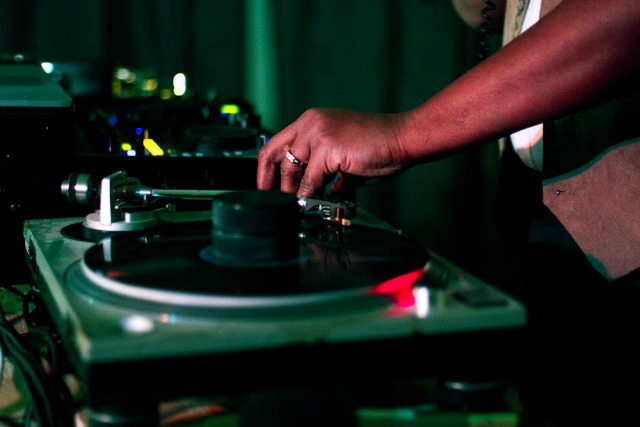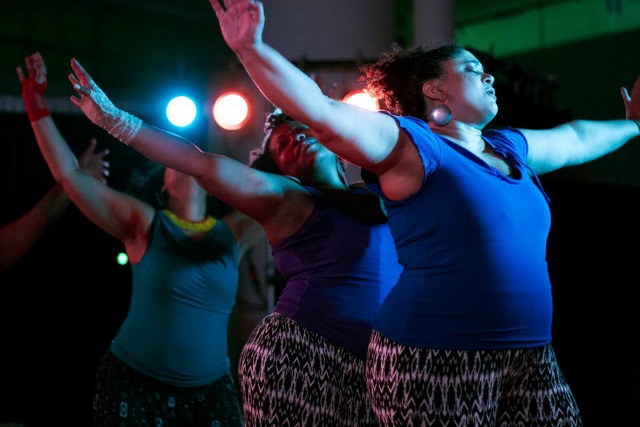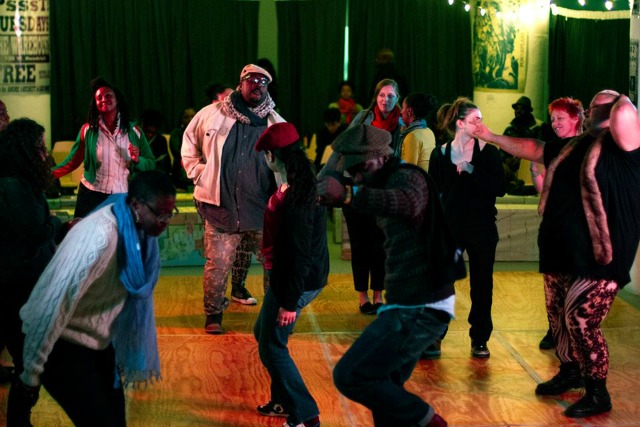Juke, Cry, Hand, Clap: Remembering Chicago's House Culture
By Ester Alegria in News on Oct 12, 2014 8:25PM
Four women fall in line, taking turns giving the crowd a brief history lesson on the importance of house and deep house music to Chicago and how the subculture’s popular landmarks are gentrified into memories.
“Welcome to a love letter,” began Meida McNeal, Honey Pot Performance’s Artistic Director. Thus kicked off "Juke Cry Hand Clap: A People's History of House & Chicago Social Culture"
Friday night, on Mana Contemporary Chicago’s premiere floor in Pilsen, the white, wide space, ripe for artists of all disciplines to fill the area with thought-provoking creations boasted an air of anticipation. The creators and of Honey Pot Performance, Abra Johnson, Meida McNeal, Felicia Holman, and Aisha Jean-Baptiste curate from the black feminist's perspective.
Honey Pot’s Mapping Sessions took over six months to complete and included collecting stories from people all across the city, encouraging them to mark a spot on Chicago’s map where they partied or had experiences with house music. The goal was to show the degradation of the house scene and to preserve its history. They are curators of sweat, a million first times, and your older siblings who always left the house looking fresh to death.
DJ Jo de Presser spun all kinds of sounds from my childhood began the opening routine with “Welcome to the Pleasure Dome”. Felicia Holman started “jackin’” then twisted her torso sideways and wrapped her arms into the repetitive “percolator” movement—a dance I remember practicing to Chicago house mixes like, “Bang, Ski” at the Markham Skating Rink with the teenagers around me juking and footworking.
(Later on that night, I was grounded because I was supposed to be skating—not simulating sex on the dance floor. This was my coming of age house experience. Dancing at all ages skating rinks, admiring the acrobatics of dance troupes like K59, which kept a lot of kids focused on dancing instead of getting into life threatening situations. It was all in fun.)
Not sure which performer to watch—all four so intoxicating—I could see the complex personalities of each dancer dripping with each shimmery bead of sweat. They were all so comfortable within each other’s arms. I craved this kind of sisterhood for myself. I craved this kind of kinship for the world. Every movement was a haiku; and the movements, forces of nature dedicated to themselves. This meta-composition was healing, empowering. I relaxed my shoulders, inviting this new kind of acceptance. This is my Chicago.
Honey Pot Performance : Juke Cry Hand Clap from On The Real Film on Vimeo.
I was there to witness an amalgamation of Chicago house experiences. I in turn, had my own re-awakening. Growing up, watching my eldest sister stain her full lips black, dressed in black pants, an oversized black top—gold accessories, and black boots as a remixed version of Ram Jam’s “Black Betty,” melded into Crystal Waters,’ “Gypsy Woman”. She bounced up and down on one leg and kicked out the other sideways, entranced by some musical entity—her signature move.”
That night, through movement and prose, I learned that the Great Migration radically altered Chicago’s African-American population. I learned that we live in a city with people who are always migrating. Constantly in search of something better. The women, moving in sync, was reminiscent of a flock of birds flying in a V pattern; perhaps migrating through Chicago also in search of that new piece of happiness.
Between performance segments, dance variations through the decades flashed on the wall projector to the soundtrack of Jo de Presser’s precise mixing. One can guess how the various styles of Chicago dance originated. With jazz, gospel, disco, and R&B influences, house is not only a type of music—it's a movement. And that movement has the fluidity and resilience to withstand humanity’s greatest enemy. Time. Chicago’s deep house pioneers may be aging, but there will always be groups like Honey Pot Performance there to breathe life into the scene, paving the way for younger generations to sweat it out at house parties, have a million first times, and always step out looking fresh to death.
Toward the end, the group pulled the collection of house related stories from a bowl and read them to the crowd, then invited audience members to read some, perhaps with the chance of reading their own stories.
The show wrapped up with Honey Pot’s slow and earthy “Juke, Cry, Hand, Clap,” in the southern black Ring Shout tradition, suddenly the entire room was on the Juke Joint’s stage dancing, including my very reluctant 7-year-old daughter who would rather draw people dancing, than dance herself.
This could be bigger. This should be bigger. Across the country. Every house head. Uniting people though music, sweat, movement, and revitalization.
House is the religion, dance the offering, and the DJ is the almighty—bestowing bass bumping beats upon our heads, flowing downwards through our skin to those special places that make us want to feel and be felt. Yeah…this is indeed my Chicago.
Honey Pot Performance's "Juke Cry Hand Clap: A People's History of House & Chicago Social Culture" performs 4 p.m. Oct. 12 at Mana Contemporary Space, 2233 S. Throop St.



